Christopher Hector looks back at the controversy that divided the world of dressage. Where did rolkur come from and why did it go away, or did it?
I was recently somewhat surprised when a series of comments on the Horse Magazine facebook page, indicated that the posters believed that Rolkur was a huge and ongoing problem in dressage today. Now I am only too well aware that facebook is a magnet for ill-informed comments, but I think it bodes well for the future if we look at the history of Rolkur, and the way in which it was eventually more or less banished from the dressage world.
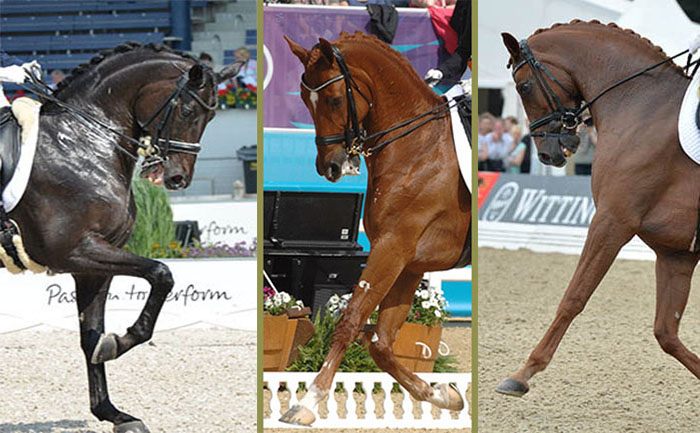
But I am also well aware that Rolkur hasn’t disappeared entirely and that there is a new fashion for short and hauled up in front that is at least a close cousin to Rolkur.
We first became aware of Rolkur when Anky van Grunsven and Sjef Janssen and Bonfire burst upon the dressage scene sweeping all before them, while at the same time a carefully orchestrated PR campaign sought to legitimise the Sjef technique.
Anky and Bonfire winning the World Cup in 2000 in the lead-up to the Sydney Olympics.
So what was the theory behind Rolkur? Back in 1999 I interviewed Sjef:
Sjef developed an interest in horses and riding more or less by accident, when his young daughter became entranced with a foal, so he bought it, and then when the local riding school went broke, he bought that too and spent the next couple of years in intensive equestrian study…
“They had just opened a school in classical dressage riding in Belgium, people who had studied at the Spanish Riding School, and with Nuno Oliveira in Portugal, people like that. They had about thirty horses that could do passage, piaffe, pirouette, all the so-called difficult stuff. I decided to go to that school. It was seven hours riding a day, two years in a row – so I did a lot of mileage in two years. Those people were very classical and I like that a lot. At the time I had to work in my own barn also – then I decided to start and compete in Holland.”
“I bought a Belgian Hanoverian that could do almost Grand Prix, and a second horse, Oran, that I had bought at the start was now three years old, so I broke him in while I was at the school.”
“I learned a lot about dressage from the people at the school, they had a lot of technique and splendid horses that let you feel the really good piaffe, and the really good passage and really good pirouettes.”
Sjeff and Edward Gal watching tests in 2011…
What is your philosophy of training?
“The philosophy behind my work is that number one, I am for classical dressage, the way it is supposed to look in the FEI rules. But my philosophy of training is different, I treat horses like athletes, instead of using the classical training methods because I don’t think they work any more in these modern times. The horses are different, there’s way more Thoroughbred in them, so you have to approach them differently, also mentally. The horses in the past were those really heavy horses, and you didn’t need to train them much in the lower frame because they were very difficult to bend and flex.”
A Warm-Up session for the World Cup Final in Los Angeles
“I think that when you show a horse you bring it up in front, and show it in its full glory, on its haunches, light in the forehand – but I think if you try to train a horse that way every day, he will not be able to physically stand it. He will get a lot of pain, a lot of back pain.”
“A lot of people are against our way of training because they think we over bend the horses and that will hurt the neck and the back, but two professors have conducted a research project, and soon there is an article to be published, and they have proved that riding the horse always up, is very dangerous for the horse, and riding them deep is very good for the horse, especially the neck and the flexibility. So what we did unconsciously in our training has now been proven very good for the horse’s well being.”
This series of pix of Anky and Sjeff was taken at SIEC on the warm up day before the Sydney Olympics started. They were in full view of other competitors and stewards, and neither Sjeff – in purple in the background – or Anky objected to the pix being taken by The Horse Magazine. I was quite close to where they were working Bonfire.
Riding the horse deep is very different from the way you would have been taught with the very classical instructors – what made you think of putting the horse in that position?
“I had a very difficult horse, the horse I had bought for my daughter – that yearling colt. He was extremely difficult, so he was a very good learning experience for me. I had to invent a lot of stuff, because in the traditional way, I was not able to ride him. I had to experiment a lot, and I started riding him deeper, more over his back, because he had a tendency to hollow his back and go short in the neck – I had to make him round and his frame got longer. That’s actually where it started, and I had very good results with that horse. That was how, he ended up taking me into the Dutch team.”
“It was just a matter of testing and experimenting. I couldn’t get him on the bit, he was extremely difficult in the mouth, very sensitive, you could not even touch him in the mouth or the back would be gone again. I really had to get a connection on my snaffle to make him stretch. It took about a year-and-a-half, and then we finally agreed – okay I’m going to put you real deep and I’m going to get the contact from there and then I can get you longer. He was also very hot and very sensitive to the leg. He was an extremely difficult horse but at the end, we got it.”
Later that day, I saw Isabell Werth and Gigolo going for a walk around the grounds of the Olympic venue…
Did you get a lot of resistance, this guy coming into the team who had never ridden before he was 28?
“There was a lot of resistance, but I stuck to the system I had developed. Every horse you have to change it a little bit, but the basics are the same for every horse. My methods were extremely different, and they hated my guts for a long time, but if you keep coming back and keep coming back, and the horse is always improving and your students are becoming national champions, then at some point they have to accept you, because the results are good.”
“I think that because in our system, the horses get very loose and very manoeuvrable, and they seem to be very happy in it, they get more beauty, they get very concentrated on what we are trying to do with them, they accept it very willingly – so if a horse is sound and happy, why change what you are doing?”
“I think that the elasticity of gaits that our horses show is a result of this training. I see a lot of horses that are trained ‘up’ in the FEI test position and after the years of work, they get more stiff and irregular in their movement. Sometimes it looks as if the work is hurting them and their gaits get worse. The results of good dressage training should be that the basic gaits get better.”
“The way we train you never see our horses go behind the bit, they are always very nicely up and on the bit. A lot of horses that are so-called classically trained, I see them in the ring and very often they are too deep. So who’s right here? I think it is very obvious.”
When you were developing your philosophy of working the horse deep, were you aware of the deep and round work Dr Schulten-Baumer was doing with Nicole Uphoff and Isabell Werth?
“That’s totally different. I can only comment on what I see at shows, but it is absolutely not our system. We work on being honestly through, and on the bit, they seem to do it a little different, sometimes the connection and the steadiness of the position is not always the same. Sometimes the connection does not seem to be straight and on two reins, sometimes they get a little too deep, and sometimes a little too much over the bit. Sometimes they tilt their head a little bit. That’s what I think is different about what we do. I think we are way more on a very honest connection.”
As Sjef said, they have to accept you if the results are good, and that they certainly were – Bonfire was an Olympic star, he collected team silver at Barecelona and Atlanta where they also won individual silver, then individual gold at Sydney where the Dutch team won silver. Bonfire totally dominated the World Cup winning the Finals in 1994, 1995, 1996, 1998 and 1999.
When Bonfire retired, Sjef and Anky did it again, this time with Salinero who won individual Gold at two Games, in 2004 and 2008, and took home the World Cup five times: 2003, 2004, 2005, 2006 and 2008.
Preparation for the halt before entering the arena at the Windsor Euros…
Nowadays it is as if this never happened, finding a judge who will admit they actually liked Salinero is a bit like hunting unicorns, but the truth is they kept handing out top marks, for work that always appeared to me tense and while the trot was huge in front with the front legs are flicking out. This near universal acceptance of Sjef’s methods and ‘sensational’ dressage was greatly aided by Dutch journalist, Joep Bartels and his annual Global Dressage forums.
And the final halt at the end of the test…
At the 2005 forum, the world’s number one dressage judge, Mariette Withages declared Salinero the happiest horse in the world! German dressage rider, Ulla Salzgeber had a different spin on it – ‘why is Salinero the happiest horse in the world when he is doing a dressage test? Because he knows Sjef can’t get into the arena with him…’
Joep also invited a number of ‘experts’ to endorse the superiority of what was being called the Dutch system of dressage, as oultined by Joep in his book Ride Horses with Awareness and Feel – The New Dressage Training System from the Dutch Olympians at Academy Bartels…
I remember asking one equestrian ‘scientist’ who said he could see nothing wrong with rolkur, just when he’d seen rolkur in action? “Oh Anky and Sjef demonstrated it at the global forum.” He seemed a little shame faced when I put it to him that if he’d never seen the practice in action at a major competition, then he really hadn’t seen it at all and it was perhaps a little irresponsible to publically bless the technique…
Lingh retires at Aachen …
So what happened, how did this new Dutch system show its feet of clay?
What stopped success-after-success for Sjef’s techniques?
Really it was the horses themselves who blew the whistle. An increasing number of horses trained this way, ended up so tense that they couldn’t actually complete a test. Edward Gal was forced to stop competing with Lingh when he began bolting down the centre line, Gribaldi declined to continue to compete, as did Voice. Anky found it impossible to stop Salinero in the test, and the gelding was so unrideable that at the WEG in Aachen he bolted out-ofcontrol from the arena in the presentation ceremony, and Anky was forced to ride a borrowed horse in the medal presentation.
It would be nice to be able to write that the international dressage judges stepped up to their role as guardians of classical dressage, but sadly this is not true. The real impetus for change came from a couple of my brave colleagues, Gabriele Pochhammer and Jan Tönjes of St Georg magazine who came out in opposition to what they called Dressage Perverted.. Right from the start of the article it was obvious that they were not pulling any punches:
“The dressage sport is degenerating. Many horses are lost along the way. Those that make it into the arena often seem to be over-trained. Hardly anyone shows interest in the principles of the classical education. There are many discussions next to the warm-up arenas and on the internet. The judges however look away, they would rather concentrate on voting for the apparently happiest athlete. If nothing else works the vet has to fix it.”
“The ship deviated from its course at some point. No-one knows exactly when. Neither the sailors nor the captain. Maybe they do not want to know. Their motto: Everything is under control on the sinking ship. Remind me, what was it again? Dressage-riding includes the gymnastic build up and thorough education of the horse, in order to fully develop its natural abilities, to increase its capability to perform well, to maintain its health and last but not least to achieve a harmony between the horse and its rider. This, translated into English, is how it is printed on page 9 of the German guidlines for Riding and Driving II. And further it is implied that under no circumstances is the rider to mistake dressage-riding with teaching the horse random tricks and magic acts instead of sympathetically educating the horse in a correct manner. Can we call that which begins in the warming-up arena and is later gaining marks which are approaching the ideal, still harmony? Or is the scenario, repeated week after week, more of the picture of a fight of man against beast? Many spectators are disappointed by what they see when watching riders prepare for the important competitions. Is this the true face of top level dressage? Those who stand close enough to the warm-up arena will soon hear people wondering about how the training might look like at the riders homes, without the public watching them.”
Although there were attempts to portray the article as a German attempt to sabotage Dutch dressage, it is obvious that the authors were quite happy to criticise German AND Dutch riders…
In 2005, the warm up arena at Aachen was closed to both the public, and the press. This image of Anky warming up Salinero was taken from the staircase on the side of the stand…
Back to that St Georg article… “No-one will doubt that the top-level sport needs individual training concepts. Two riders and their trainers have been warned in Aachen in 2004, not officially of course – judge Christoph Hess spoke to the trainers: The way Isabell Werth and Anky van Grunsven prepared their horses for the competition received negative attention of the audience as well as the official steward.”
Martin Schaudt had received complaints the previous year…
“As most are aware, van Grunsven won the Olympics in Athens a few weeks later on Salinero, Isabell Werth can only maintain control of Satchmo in patches now and Schaudt’s Weltall completely quit cooperation with the rider during the freestyle in Athens, but later, during the indoor season, rose like phoenix from the ashes and gained world record points in the Grand Prix Special. Each of Weltall’s outings is followed with excitement. They speak of genius and insanity, the same applies to nearly every world class horse, apart from the diligent worker Gigolo. We are thinking of a genius when we watch Weltall’s legs during the passage and piaffe, sticking precisely to the rhythm like clockwork; insanity when he does not manage to complete a test without making fundamental errors – errors related to the very basics of a horse’s education, such as the rhythm in all three basic gaits. This is a fate which Weltall shares with Satchmo. Although Satchmo sticks to the rhythm, he is not obedient. Isabell Werth abandoned her plans to start at the German championships in Verden after her future prospect – who seemed to have been on his way up at that point – abandoned his share of their combined effort to finish the test whilst competing in Balve. And also Nadine Capellman’s future prospect Elvis, which many predict to have a great career ahead of him, quit his duties and bolted across the warm-up arena, instead of doing the piaffe – apparently, as claimed a few days after the incident, due to a trapped sciatic nerve.”
more on Salinero follows
Anky and Salinero – winners in Las Vegas
The sub-heading in St Georg was – Crime scene warm-up arena
“There is hardly any competition without debate. The audience complains. Some protested against van Grunsven’s training methods in Las Vegas and increased the pressure on the steward until he eventually approached the Olympic medallist. For Mariette Withages, chairman of the dressage committee of the FEI, it was just a little side comment – well, she just rode Salinero very deep, this is how it is done nowadays. And as the judges only judge what they see during test, the horse and rider combination gained record marks in the freestyle to music and even a 10.0 for their choreography of the German judge Uwe Mechelm. Later, on the phone, questioned about the incident in the warm-up arena, Mechlem claimed not to know anything about it: Oh, did that really happen? It seems as if the judges sometimes resemble the three wise monkeys: blind, deaf and dumb. To open one’s mouth could become rather uncomfortable – after all the rather chummy dressage society meets weekly and it would be upsetting not to remain friends with everyone.”
The incident in Las Vegas –
Anky on Warm Up day in Las Vegas in the main arena. She was holding Salinero’s head down so she could control him. There were some members of the Public on the opposite side of the arena who observed the incident – they had been able to buy tickets for Warm-Up day and there was a sizeable crowd. Salinero wouldn’t work with the Press in the corner, especially after some cameras came out – it was an area set aside for the Press – perhaps because they were taking photographs of Anky working him very deep… Sjeff came and insisted the Press move from that side of the arena…
Back to St Georg”This is how it is done nowadays – maybe that is the sticking point. Observations at the warm-up arena during the World Championships of Young Dressage horses: Five and six year old horses, ridden by Dutch riders, are being prepared for their big outings. Seemingly the horses are biting into their own chests. The rider pulls the reins towards his abdomen whilst holding his hands extremely far apart, the head of the horse gets yanked from one side to the other. Then he stops. Repeated pulling, a quick kick with the spurs, the horse trots on. Not even three metres later he stops again: The rider moves his legs away from the horse‘s body, leans back with all his strength. Again the reins get pulled left and right. The horse’s nose is approaching the 45° angle behind the vertical, the neck is tightly rolled. The same moment the horse comes to a standstill, the rider‘s leg gains momentum. Again the spurs, again halting, again left and right on the reins.”
“Scenes like these are not rare. And of course the German riders are just as capable of riding their horses that tight and that deep. Only the methodical, the strict repeated biting into the chest, is not – yet? – the norm. The piaffe also gets carried out in this posture – shortly before entering the Young Dressage horse class, as shown by one of van Grunsven’s students.”
A very elderly Bonfire enjoying a warm winter in his stable…
St Georg article continued “The Dutch national trainer Sjef Janssen has been questioned many times relating his training methods. He repeatedly stressed in interviews that, what he calls long and low is beneficial for the horse, and that, in his opinion, the classical education harms the horses. His best argument is Bonfire, winner of the Olympics 2000, which is still fit as a youngster although he is 23 years old. And it is Bonfire, as can be seen on Anky van Grunsven‘s website, that Sjeff takes out of his stable every now and then to do a bit of piaffe. With an extremely deep head carriage, of course. It looks like the method which Nicole Uphoff and Isabell Werth brought to perfection, based on the training with Dr Uwe Schulten-Baumer, the ill famed rollkur, discredited by ST.GEORG. But Janssen disagrees. He told The Horse Magazine of Australia that his method of training horses has nothing to do with this. In his opinion the rolkur results in problems with the horse not remaining in a steady contact.”
Sjef and Salinero at the Beijing Games Trot Up
“ Happy Athlete
“The long haired Dutchman has always been an Enfant terrible; his fans point out that the rejection of his training methods might be a result of him being different from the ladies in pearl necklaces and the gentlemen with silk hankies lurking in their pockets.
You can only judge what is happening during the test, Withages explains to the ST.GEORG in an interview after the Olympic Games, in order to eliminate all prejudices against the warming-up methods. The stewards are responsible for the supervision: I rarely stand by the warm-up arena when I am judging. I feel I have no right to be there at that moment. She admits though that certain training methods are a case for the vet. Soon after publication ST.GEORG received an email from Sjef Janssen. He immediately took that sentence as a criticism of his training method. The debate about Anky’s methods – which also her star student Edward Gal uses successfully – does not interest her anymore, said the Olympic Gold medallist in an interview, published in the current issue of the Magazin Hors International distributed by the Dutch sports marketing agency BCM. After all, her students are successful. Bonfire was at the peak of his performance at the age of 17 and her horses are happy and healthy. They are said to live a blissful life and are neither being maltreated with spurs nor do they have blue tongues.”
“The voices that grew louder in Las Vegas have been commented on by Janssen in the Dutch magazine In de Strengen. His reply: Ignorance. At the same time he is defending the freestyle-inventor Joep Bartels, during whose Global Dressage Forum, Salinero was voted as the Happiest Athlete. The veterinary proof, that his training is not harmful, which is the opposite of what most vets claim, is meant to be made this year. The happy-athlete-rule has attracted the French Colonel Christian Carde to the discussion. He writes on the website www.allege-ideal.com how unfortunate he finds the newly formulated FEI article 401, with which the term Happy Athlete has been introduced to the regulations of the international federation of equestrian sport. He also commented on the long-and-low training pictures. His question: Why do the supporters of this training method seem to try to prevent publication of photos and discussion of something that they believe to be the ideal? If this is only about misunderstanding a training method, why not give a plausible explanation? Carde demands not only an open debate, but also the formation of a panel of experts made up of trainers, vets and ethologists (behaviourists). At the same time he questions if such a panel would show enough courage to let loose the Tsunami of objections that would follow.”
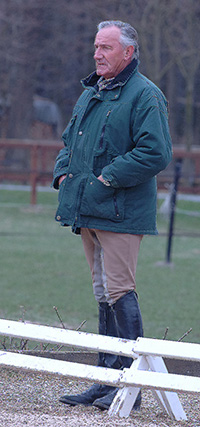
Klaus Balkenhol, trainer of the American Team, and medal winner for Germany
“One dressage expert shakes his head, one who passionately expresses his support for the classical way of riding: Weary of what he often has to witness in the warm-up arena, he openly wonders if it makes sense to give marks for the warming-up prior to a test. A rather new approach, laughed at by many. But what, if such a marking scheme would have been in place at the Dutch Championships in Nijmegen, during which van Grunsven was openly dreaming about results in the region of the 90% mark? Indirectly such marking schemes exist, and the results are poor, as pictures from this event have circled around the world. A Swedish dressage rider had been given these pictures and published them on her website Dressage for the 3rd Millenium. All horses are seen going far behind the vertical, though this is an utter understatement. ST.GEORG also holds these pictures. A frantic witch-hunt has started in the Netherlands to find out who distributed these pictures.”
“Vet Dr Gerd Heuschmann, who started a debate about current training practices by holding a talk on functional anatomy a few years ago, is speechless. The vet, who had been an education advisor with the German Federation of Equestrian Sport (FN) prior to becoming a veterinary surgeon, is pointing to the pamphlet, Animal Welfare in Equestrian Sport by the German Federal ministry for agriculture. Pain and harm, induced by excessive flexion is an offence against animal welfare. And of course there is the German law for the protection of animals, paragraph 3, 1b: It is forbidden to use methods on an animal, either in training or competition, which are associated with pain, suffering and harm and which can influence their potential for achievement.”
Bulges on the neck
“The dilemma: An international or at least EU-wide animal welfare law does not yet exist. And the FEI remains rather vague in their code of conduct regarding the horse’s welfare to which competitors subject themselves when entering the competitions: The welfare of the horse has to have priority, this for example also applies to the methods of training. Speaking of which – what is fairly common in Holland is the training with shoes which initially were used driving Hackneys, Tuigpaarden and Fresian horses. Wear and tear when using this method, with which you could even turn a cow into a piaffe and passage super-animal, is a certain outcome.”
“But also without the puppet-strings, the faulty riding has reached not only the top level sport. In veterinary surgeries Heuschmann gets confronted day in day out with the harmful changes in the horse’s body caused by riding in a constant, extreme over-bend. The complete so called upper tightness (cervical-, thoracic-, and lumbar spine as far as ilio sacral joint) including the rump gets badly affected. Inflammation occurs, which might later lead to calcification. Real bulges are formed, sometimes even as big as a child’s fist. All of this is painful and can lead to permanent loss of use of the horse. Such clinical pictures have risen in numbers lately. Heuschmann counters the supporters of the thesis, who believe horses become more submissive if ridden with a pronounced over-bend, which apparently after all resembles a form of stretching, so far they have not yet looked further into the group of muscles which actually carry the rider’s weight. These are mainly the abdominal muscles instead of the long muscles in the back.”
“ST.GEORG expert Dr. Karl Bobel points to the lack of knowledge amongst the dressage riders, with regard to physiological consequences. Dressage is by now the most health-problematic sport because the horses do not get turned out. Out of fear of injuries the horse gets taken out of its stable for the training, after hours of standing still, and immediately gets subjected to constraints. Blobel reminds us that not only all muscles, ligaments and tendons but also the digestive system needs a certain amount of work load. This, when the majority of training methods aim at subordination cooperation, usually falls by the wayside. And what if everything else is too late? When the ligament in the neck is inflamed, the vet surely can help. He simply takes those parts, that cause the nuisance, out. Apparently the horse can be used again one year later.”
“Dr. Blobel wrinkles up his nose: Clinical diagnostics in the cranial area of the spine are difficult, even experts come to completely different conclusions when interpreting radiographs. We also don’t know exactly to what extent anatomical adaptations really influence the horse’s performance. The vet’s ambitions are a further aspect which plays a major role: Every vet, every surgery is of course tempted to try new forms of therapies for all the new problems which keep surfacing. But in my point of view the majority of new therapies have not led to success. Blobel sticks to his conclusion: Dressage riders have to re-educate themselves, they have to allow their horses exercise without constraints, and then they will remain healthy. The riders have to inform themselves what happens in and around their horses during training. They have to get to know their horse’s training-psychology.”
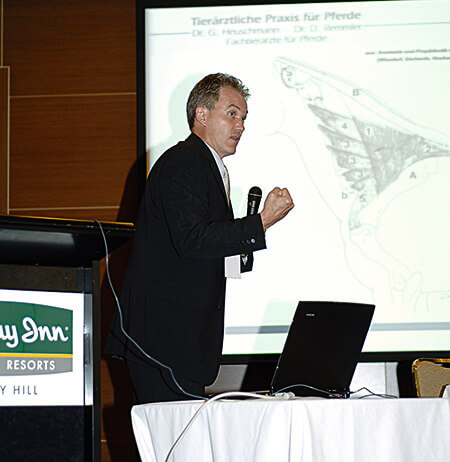
“Heuschmann follows a second starting point: Back to the roots. It is the overload of the three to four year old horses, their industrial commercialisation, which opens the door to early wear and tear. Collection is attempted way too early. Only a horse, which has been worked long and low for long enough, has the chance to develop enough strength. The most sensitive measuring device is the improvement and retainment of the natural basic gaits. Many four and five year olds show an impaired footfall in the walk and trot.”
Threat by email
“Following emotional debates on the internet surrounding the pictures taken at the Dutch championships, the publisher of the website Dressage for the 3rd Millenium received an email from Sjef Janssen. He threatened to take legal action, as the personal rights of Anky van Grunsven had been violated. He further made his opinion known, that the web-publisher had no idea what she was talking about. His riding principles were good for the horse’s build-up of muscles. Publishing the warm-up pictures was dishonest and manipulative. Our horses love to work for us. She should furthermore watch the show-jumpers during their training – there are many similarities. Then he threatened to involve his lawyer. A lot of effort – considering Janssen does not get tired of advertising his method as gentle for the horse. Why then, if it fills the horses with joy, is it not allowed to publish pictures of it? Such emails were sent by Sjef Janssen a few times. The American Kyra Beth Houston recieved an electronic letter in November 2004. This time because of video recordings, which the American took in Aachen. She has an agreement with the Aachen-Laurensberger Rennverein (ALRV) since 2001. In the USA, South Africa, New Zealand, in short all dressage enthusiasts outside Europe, the videos are in fashion. They show tests from the view of the chief judge at C, including the marks given. The feedback is great, says Beth Houston: What does a 9 look like? People get their questions answered and they love it, especially during judging seminars. And of course it can be seen that, for example, a horse, which, during the initial halt, hardly stands still for one second, can still get the high marks. This had to be stopped. Kyra Beth was told, she is violating Anky van Grunsven‘s personal rights. She was not allowed to distribute any videos. The American took the matter to the ALRV, which did not react for a long while. Half a year later they sent a new contract with the request to show them a written consent of each filmed rider. However, the personal rights of top class athletes are restricted by law during public appearances. It is clear for media- lawyer Dr. Rainer Stelling: Although every person has to give their consent before a picture gets published, there is an exception: If somebody is, and has been for quite some time, of public interest, this consent is not needed. This also holds true for top-class athletes, especially if they are taking part in competitions which will increase the public interest in them. This does not apply to a commercial use. This has now reached the CHIO-organisers as well, who selected van Grunsven and Salinero to be their star guests during the weekend prior to the CHIO.”
“Show organiser Frank Kempermann replied when asked by ST.GEORG: It is written in the invitation, that we, as the organiser of the event, have all the film and video rights and we are allowed to sell them on. Riders have to accept this when entering the competition. Hence Kyra Beth Houston does not need to collect consents, and a filming ban for 2005 does not get mentioned anymore. As a matter of fact she has a two-year long agreement. Recordings of the warm-up arena are not included, but every spectator certainly has the right to go there and have a look. And they should not allow anybody to take that right away from them.”
St Georg pointed to another problem: Celebrity-Judging
“The Problem of the cruel training methods in dressage is also the problem of judging. Where are the judges who are able, or would like to be able, to distinguish between a correctly schooled horse and a horse trained to show spectacular movements with the help of all sorts of dubious aids? Many judges have difficulties to see whether a horse swings properly from behind or only lifts its legs spectacularly in front, but with nothing to match behind, explains a Grand Prix judge to ST.GEORG. A new handbook, in which it is exactly explained what mark is to be given for which fulfilment of the required task, is supposed to help. Therefore judges, who maybe only judge a big competition once a year, only have to look at the list. Or alternatively at the large score board, on which the marks for each separate movement are already shown during the test. It is ok for the audience, but when judges can see that their marks differ considerably from those of their colleagues, they will adapt their marks for the next movement, explains the previously mentioned Grand Prix judge to ST.GEORG. And that can hardly be the intention. At large premises, such as Aachen, the electric score boards are placed in such a way that they cannot be seen by the judges.”
“Judging dressage competitions is a thankless job: Only the winner is usually content. And as judgements contain a considerable amount of subjective arbitration, discussions about results after the competition can be endless. This has further increased with the introduction of the freestyle to music. Marks for components such as a nice choreography or suitable music make the final judgement necessarily even more subjective.”
“The organiser, who invites the judge, is happiest when the winner also is a celebrity, who he was able to attract to his event, and who he used to advertise that very event. The winner is more inclined to return the following year. Judges however are easily replaced, they simply do not get invited anymore if they make too many unpopular decisions. It does not matter how right or wrong those decisions were. Most judges, whether they openly admit to it or not, internalise this. There are three ways of judging: collective judging, separate judging and celebrity judging, so it is whispered – especially with the VIPs in the saddle, showing their spectacular performances, and the question of how they trained their horses? It is better not to ask.”
The article caused an immediate furore and Sjef sued Gabriele personally but the genie was out of the bottle. The dressage public said enough is enough, and set about monitoring the scene themselves with the assistance of their phones, hiding in the warmup arena was no longer an option.
A surprise win for Great Britain Team at Rotterdam in 2011, a change for the Dutch on home-ground – Carl Hester, Emile Faurie and Charlotte Dujardin win and Carl lets Charlotte be spokesperson.
Carl’s rubs his head in disbelief at his score on Dutch soil
Carl and Uthopia show the Dutch crowd a different look
The beginning of the rise of Charlotte and Valegro
Carl was reduced to wiping away the tears at the performance of his protege…
Once again, it was the horses turned the whole situation around, at the 2011 European Championships a pair of extraordinarily talented and sensitive riders, Carl Hester and Charlotte Dujardin demonstrated how beautiful harmonious dressage could be, and were duly recognized by the judges. The tide had turned with Charlotte and Carl. as was conclusively demonstrated at the London Games.
Now in 2022, they have been joined by an army of sensitive harmonious riders – like Kristine Bröring-Sprehe, Helen Langehanenberg, Cathrine Dufour, Maria Caetano, Jessica von Bredow-Werndl, Juliette Ramel, Rodrigo Torres and Adrienne Lyle, who keep winning all the important tests.
It’s interesting that what has happened was ever-so-accurately predicted back in 1936 by the administrator who saved equestrian sport in Germany, Gustav Rau:
In his book, Die Reitkunst der Welt an den Olympischen Spielen 1936, Rau included a chapter – Suggestions for a Modern Riding Instruction based on the Classic German Tradition. It is hard to believe that his advice was written 80 years ago, Rau could be writing about the current dressage scene…
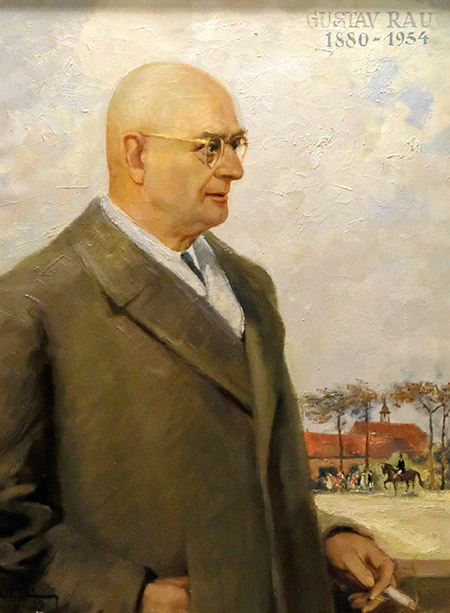
Could he have been warning against the Rolkur fad when he argued strongly that the equestrian future should be grounded in the past, on ‘the constructive work of many equestrian generations’ and warns against ‘speculative destructiveness’.
“Shaking with speculative destructiveness on the building of German equestrianism must be prevented.”
Rau assured his readers that any deviation from the time-honoured German way would only be temporary – like the way Rolkur was finally discredited and banished:
“The temporary departure always takes place after exaggerations of what has been handed down, as they consist in holding the horses by too much influence with the hand, suppression of the natural paces, exaggeration of the artificial equilibrium. The reaction against the traditional is in the form of exaggerations in the opposite direction.”
“From the gradual development of the dressage, to the increasing gymnastics of the horse, according to the different requirements to which the horse is to be used, it is a logical structure, a system that will survive as long as the German people are riders. A system that can always meet all requirements and contains the germ for the preparation of the horse to any kind of use – for the training of the horse for special purposes, such as cross-country riding, show jumping, and dressage tests at all the levels. No special systems are necessary whose one-sided fulfilment requires special detours of training, but the total system provides in its various stages the degree of ‘throughness’ and its consolidation for horses for every purpose. The system of traditional German equitation creates in its gradual gymnastic training of the horse, the foundations for the future specialised skills.”
We owe a vote of thanks to those two courageous St Georg journalists, and a huge vote of thanks to Charlotte and Carl for showing just how wonderful dressage could be…
2012 at the London Games
Carl Hester, Charlotte Dujardin and Laura Bechtolsheimer – Gold
Charlotte Dujardin and Valegro
Carl and Uthopia
Bronze for the Dutch – Anky, Edward Gal,and Adelinde Cornelissen – the German team won Silver
And Salinero – he had to be led by two handlers out of the Presentation Ceremony…
Breeding your own dressage star in Australia this upcoming season?
Go to www.ihb.com.au and choose from the amazing range:
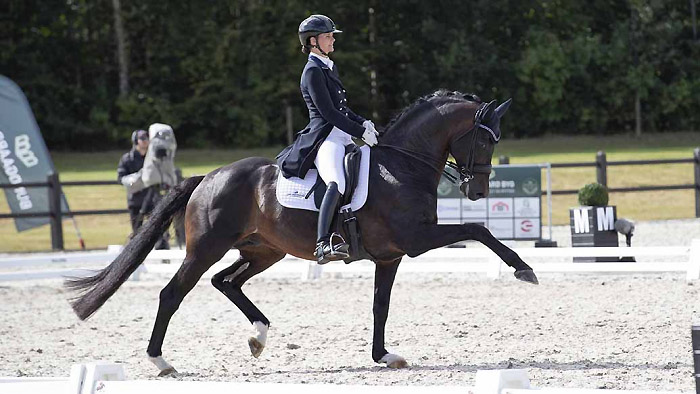
Franklin
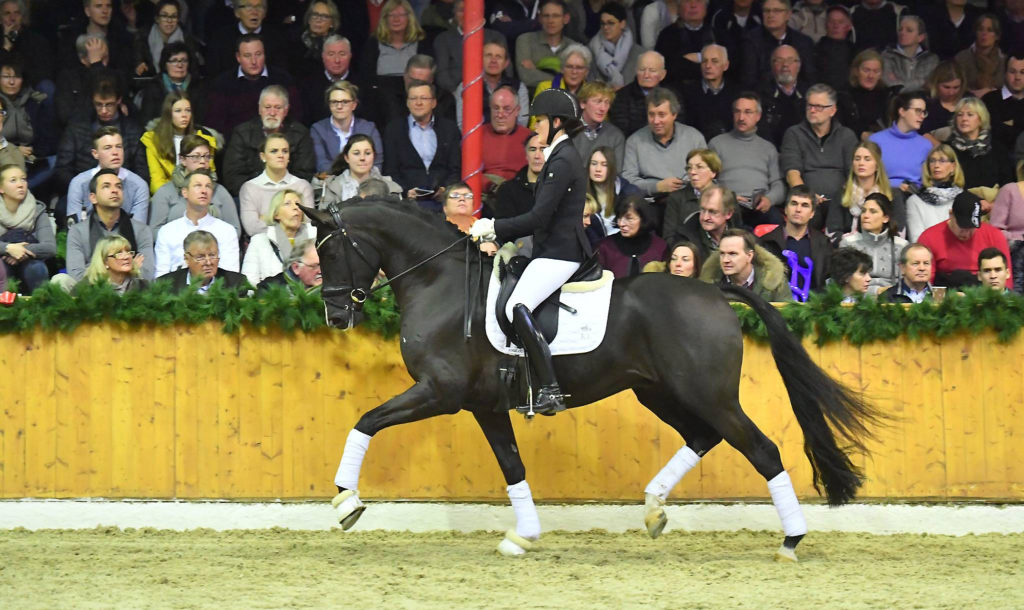
Danciero



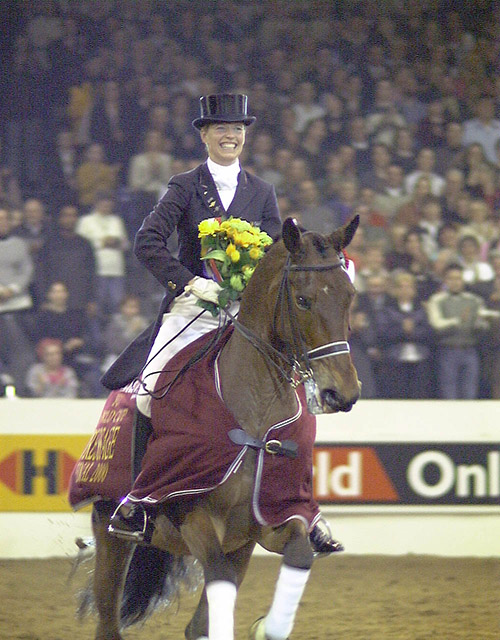
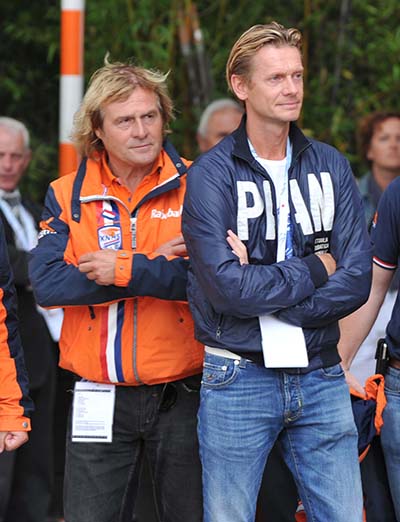
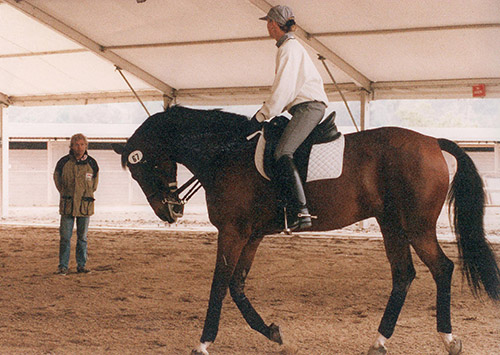
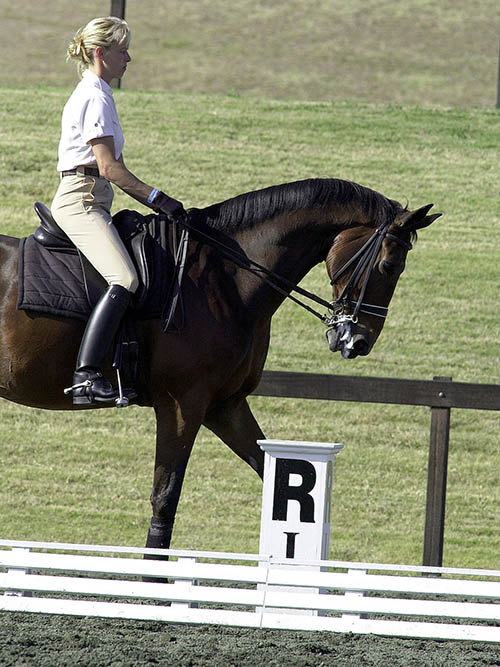
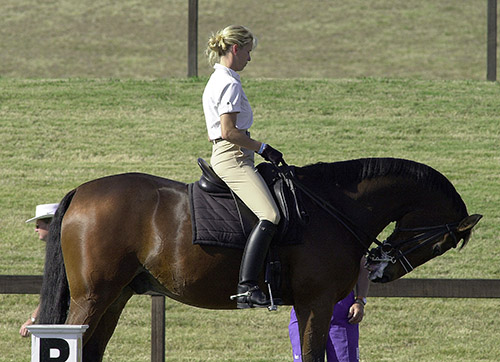
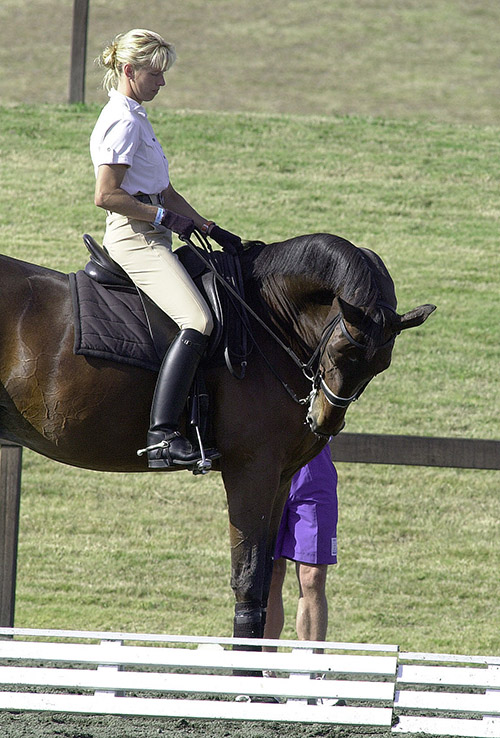
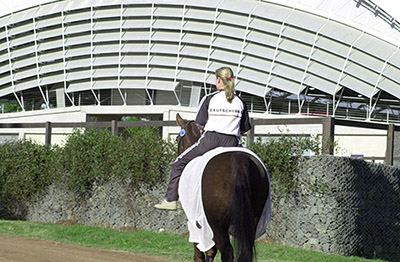
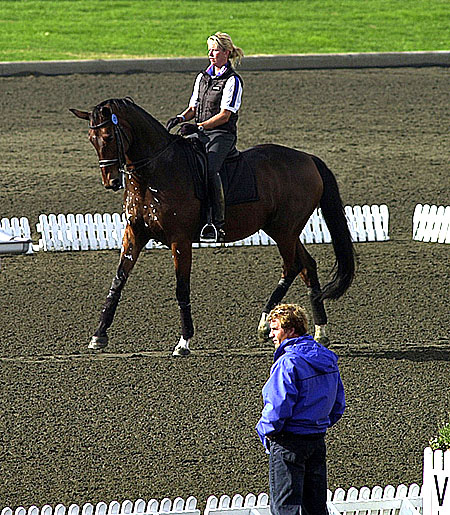
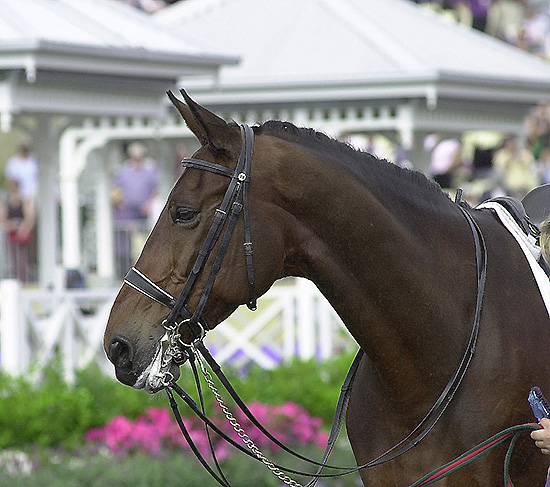
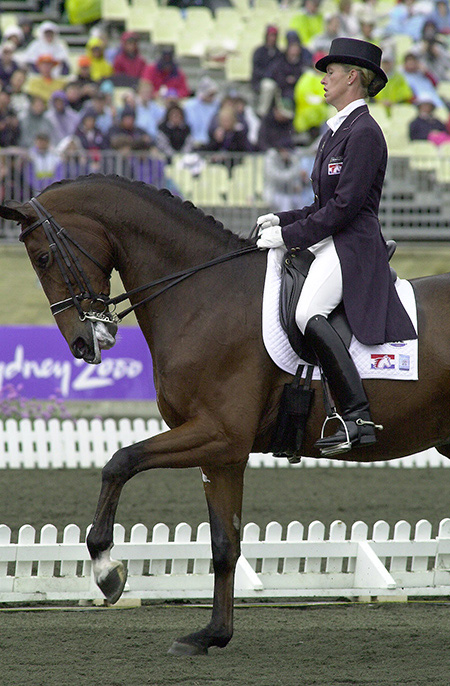
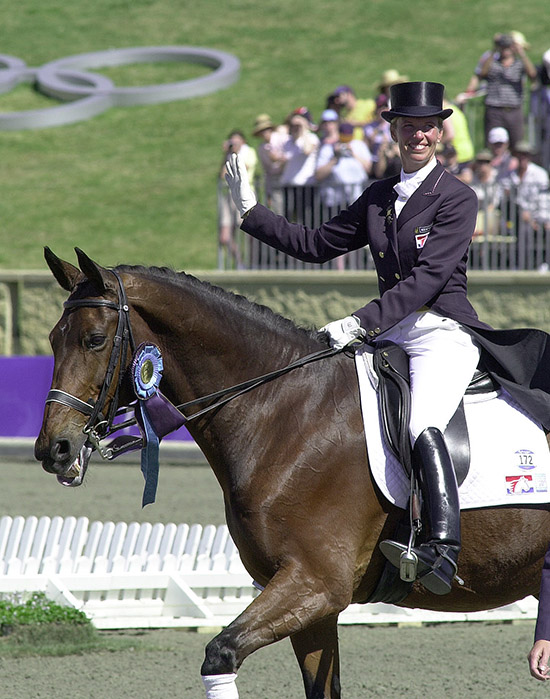
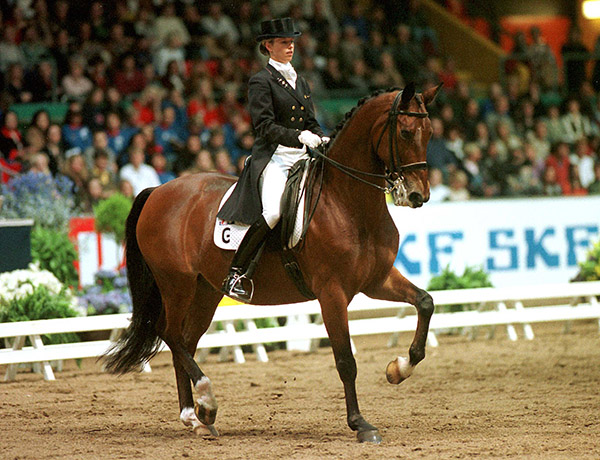
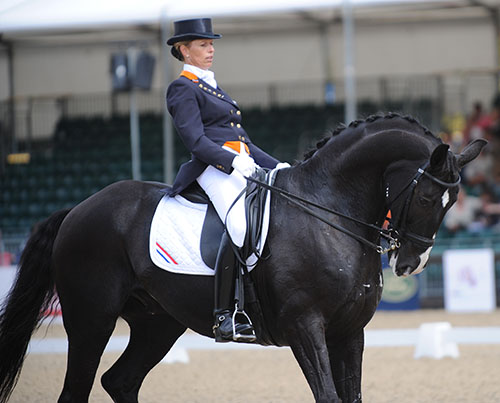
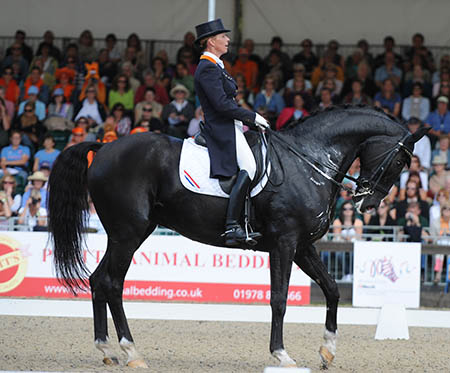
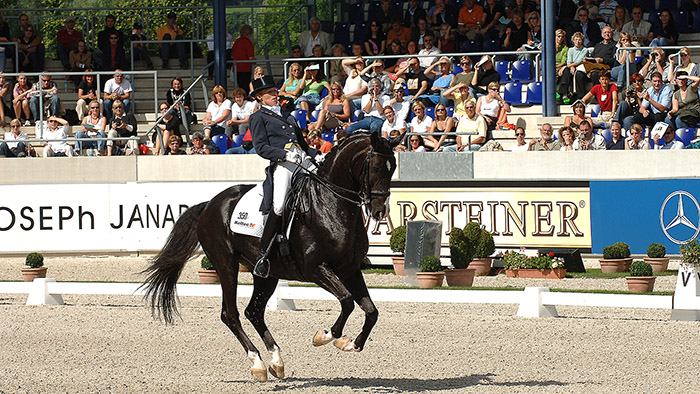
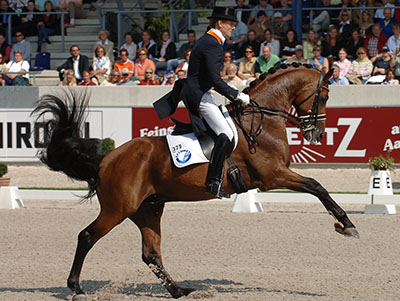
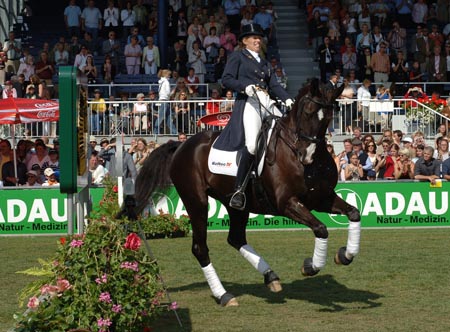
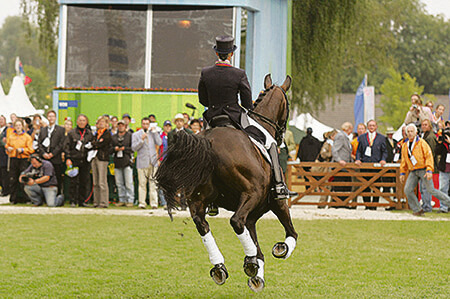
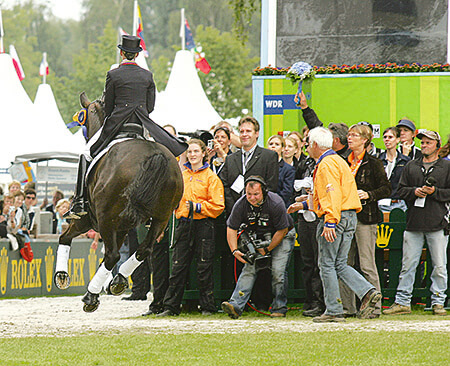
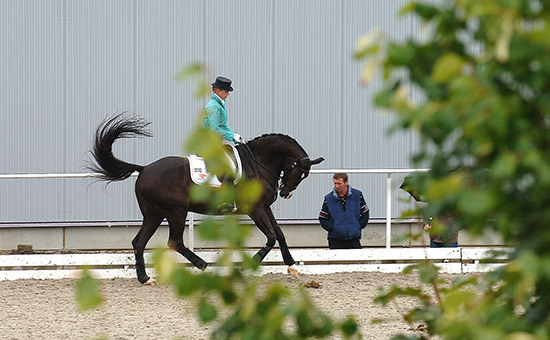
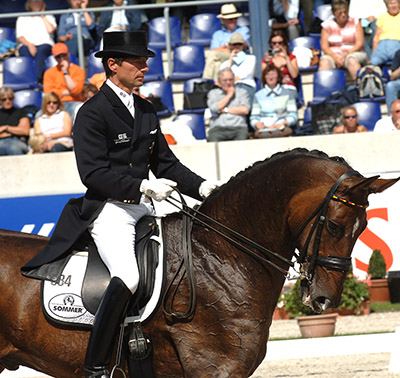
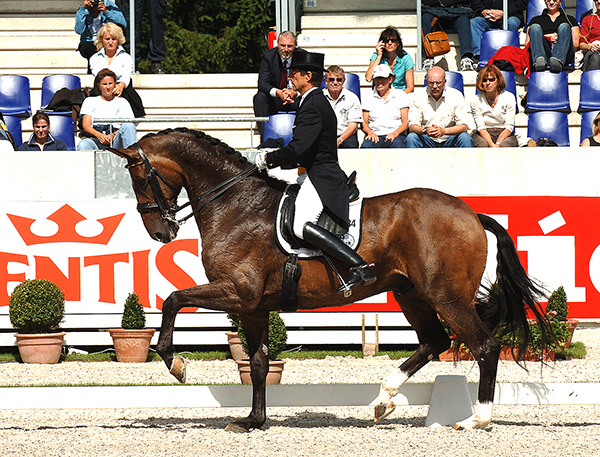
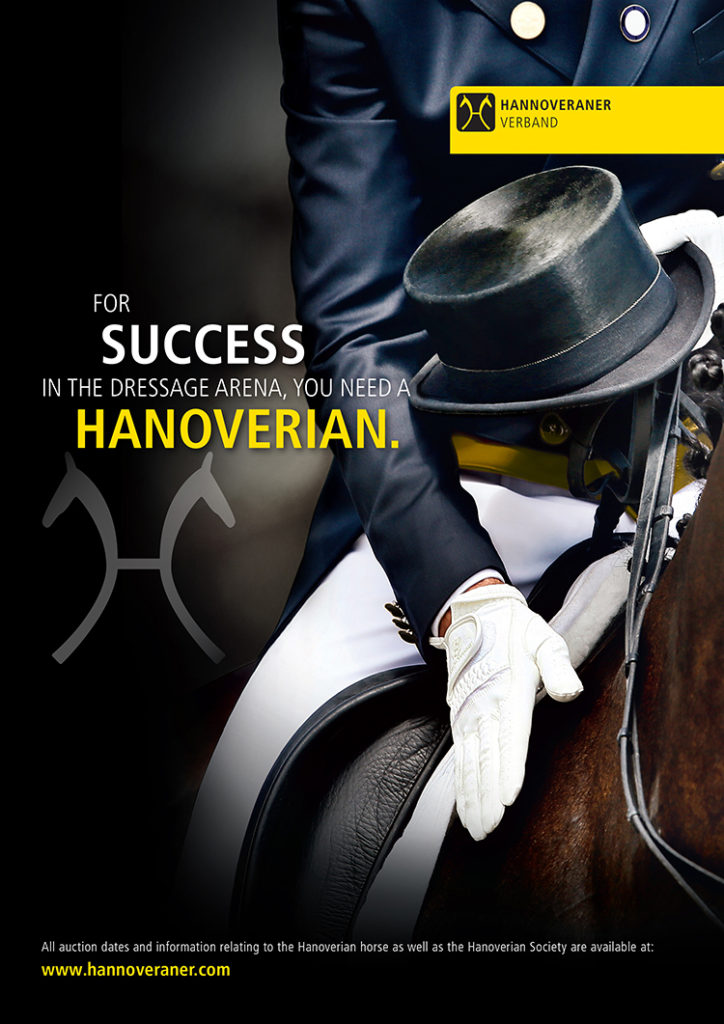
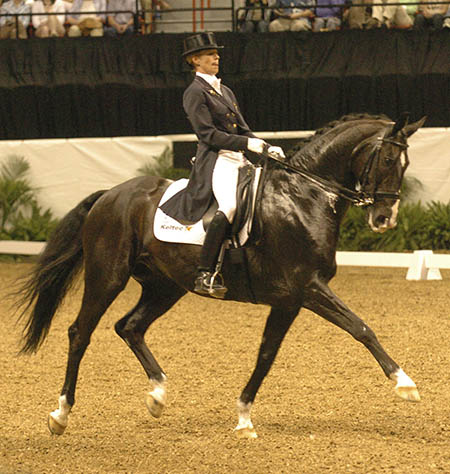
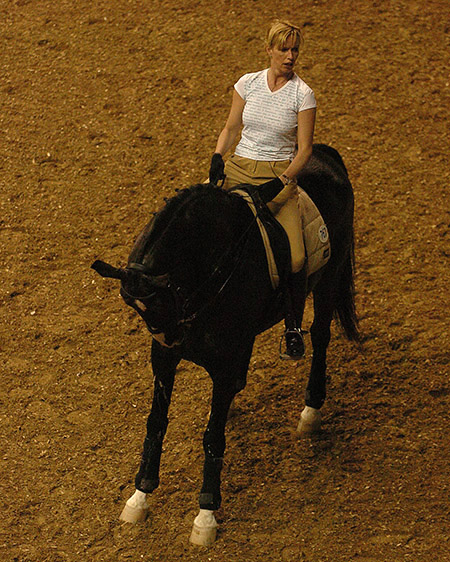
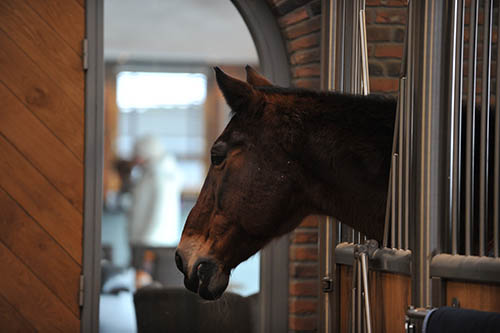
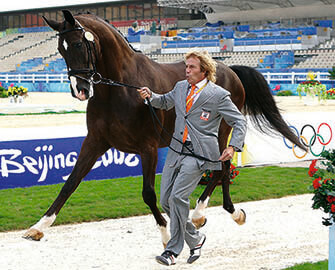
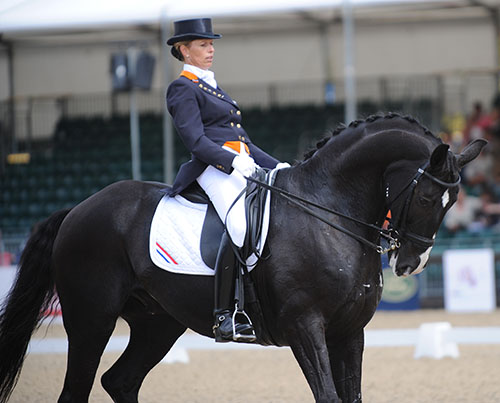
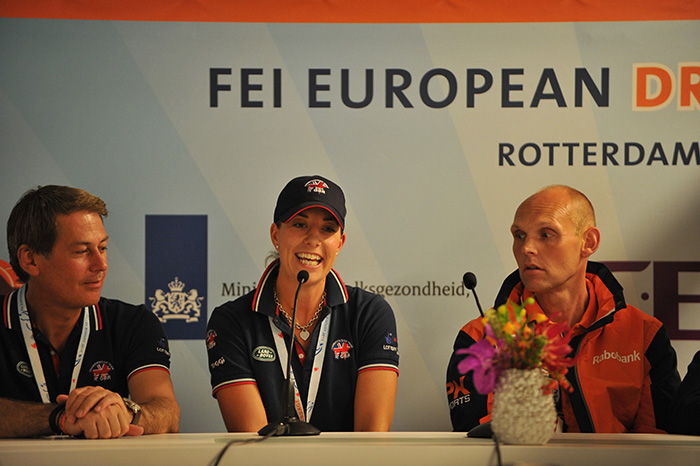
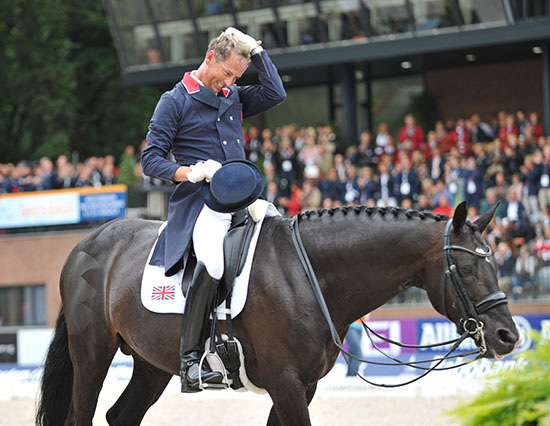
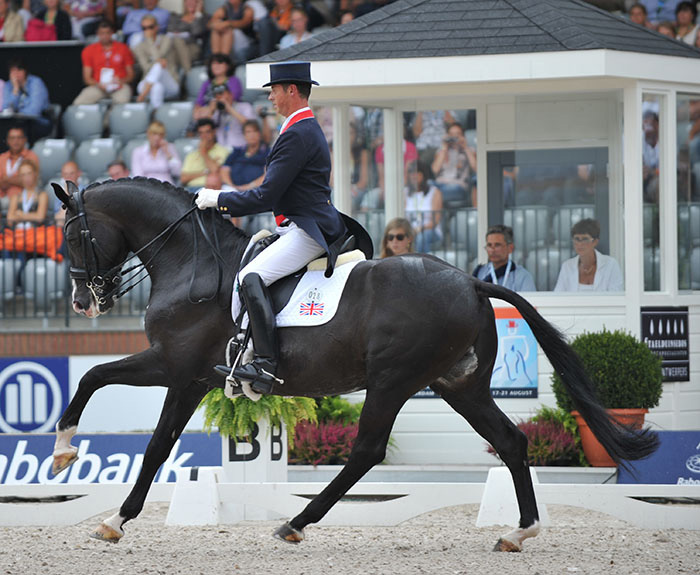
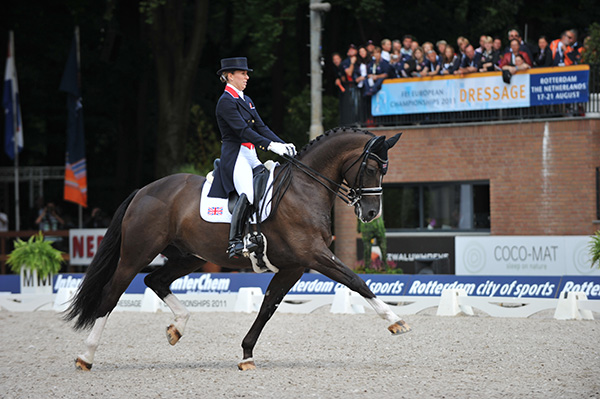
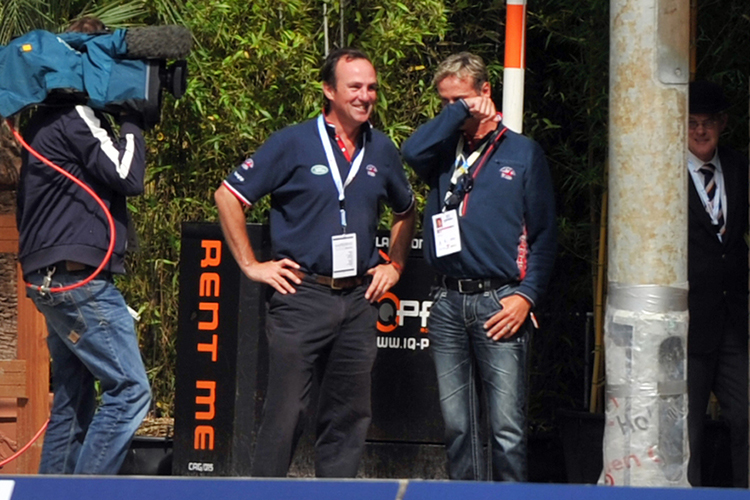
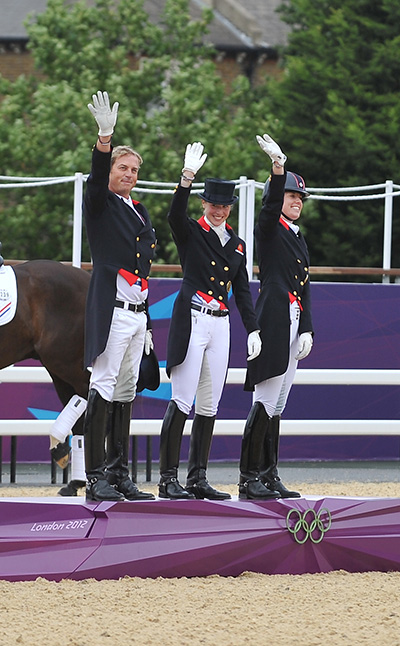
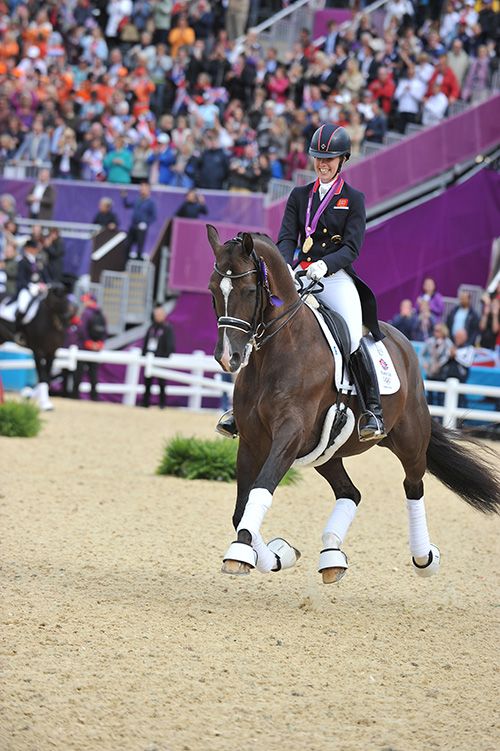
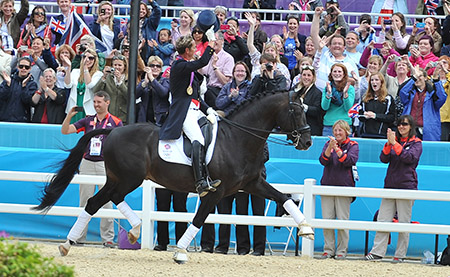
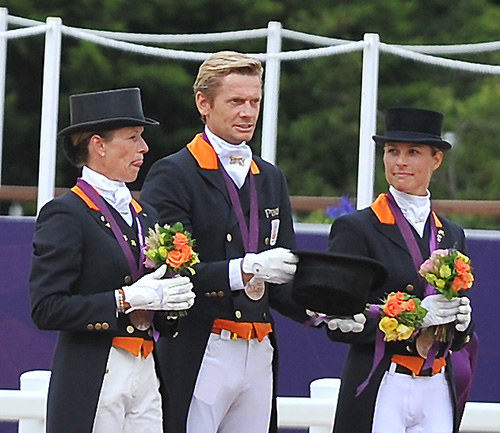
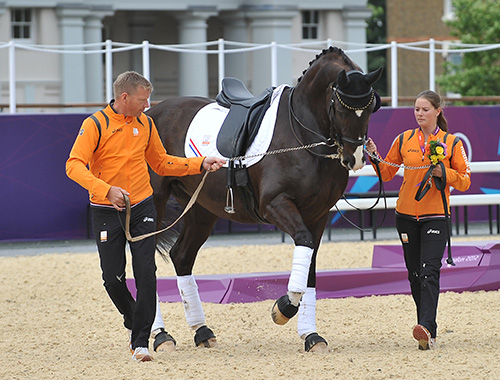
Any compression of the head/neck position is actually physical/abuse of the horses and in Australia is illegal, it is a crime.
Want to have discussion about this?
Thank you! Well written! Brave!
Competition will often bring the worse in humans and horses are paying a high price for those inflated egos and financial gains. Excessive flexions and ridiculous knee action are a reminder of Tennesse Walkers and the Saddle bred culture in the US, not much difference, all for the visual effect and anything goes in the training to get maximum effect.
But now we have a 5* judge telling our young horse riders to “bring his head around so he looks at your boot”. Apparently that makes him better?
Another younger judge telling disciples that the horses bred today are so free in the shoulder that they can’t take the same big strides behind. If that were really the case they’d be falling over all over the place.
We mustn’t listen to such ignorance.
Great article.Heuschmann is right, out on the field with the horses. I think there are more horses injured with all the stupid machines some riders use than in the field. And celeberty scores – Well they do still exits. Especially one German rider. However it has changed a bit.
I’m looking at young horses in an Auction right now in Germany and I can tell you almost every single horse is over produced, if not rollkeur something very much like it. Training young horses behind the vertical is rollkeur in its embryonic state. Out of the entire lot of dressage prospects only one possibly two (at a push) are really naturally this gifted and these I only want to to see long and low which they never show. The rest I worry for the damage having been done. So bad is it I have started to look at the jumpers with more confidence for a dressage prospect. Jumpers are spared these forced training methods in basic movement at least. It’s easier to see whats coming from where far a natural balance and power and overall potential without health problems goes. Yes even though tripping along on their forehands i get a better impression of the horses potential, one hundred percent so.
Are we the consumer to blame paying top price for young horses that are over produced. We create that market after all. Maybe it’s time to stop.